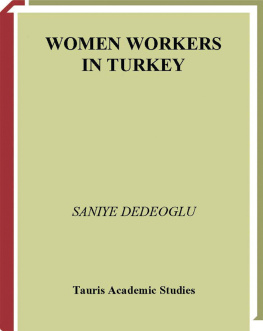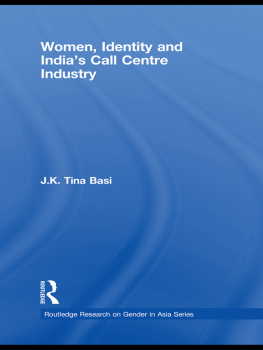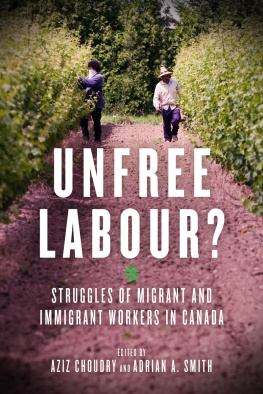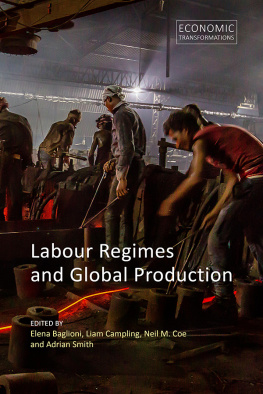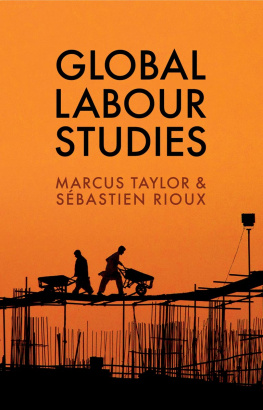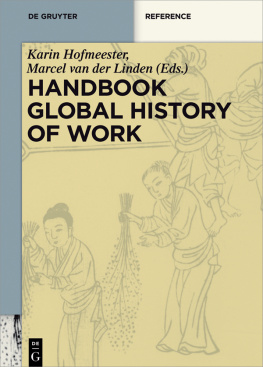WOMEN WORKERS IN TURKEY
To my parents
CONTENTS
This book would not have been possible without the intellectual, practical and emotional support of family, friends and colleagues. Many people made important comments on drafts of chapters that eventually became part of this book. Among those, Deniz Kandiyoti deserves my foremost gratitude who generously shared with me her time and knowledge. Ruth Pearson and Jane Wills provided valuable comments that improved the research further.
My very special thanks are for my parents who provided me with a very strong fall-back position at all times. Financial problems and emotional times were all eliminated due to their undying support for what I wanted to do with my life and their enduring love for me. A warm thank you is due to two friends in Istanbul: Sultan Atlgan and Nurten Ate. Sultan Atlgan shared with me every step of my work and this process would have been harder without her. Nurten Ate supported me with all the documents and books that I needed to read for my work or sometimes for my heart.
Solmaz Tavanolu made plenty of time in her busy life to read the final version of the chapters. Traute Meyer, Wendy Bottero, Graham Crow and Viv Mackay were great supporters. Bruce Hunts offer of English correction was a great relief. My utmost appreciation goes to all these people.
A very special thanks goes to my partner, Gkhan Atlgan, for his support and encouragement.
Finally, to the women in Istanbul who generously opened up their homes and hearts to me, no words of thanks are enough. I only hope that I have managed to remain somewhat true to their own perspectives and stories, and that these perspectives will find their way into broader debates about low-income working-class women and strategies for advancing womens interests in Turkey.
This book explores and explains an apparent puzzle in the literature on gender, globalisation and development. One of the best documented trends in global manufacturing has been the expansion of the female workforce since the shift to export-oriented industrialisation from the late 1970s onwards. Both statistical and qualitative studies, especially in the rapidly industrialising countries of Latin America and Southeast Asia, point to a marked increase in womens labour force participation.
In Turkey, however, despite the surge in export-orientation following the economic liberalisation policies of the 1980s we witness seemingly stagnant or slightly declining levels of recorded female labour force participation. This is despite the fact that the garment industry, a major employer of women worldwide, played a central role in Turkeys export drive. How may we explain this discrepancy? In what ways do the particular forms of deployment of female labour in Turkeys garment industry contribute to womens near invisibility as a workforce? How do global demand factors that shape the garment industry in Turkey interact and intersect with local supply factors that embed women workers in their families and communities? These are the key questions tackled in this text with meticulous attention to the links between the macro and micro-level determinants of womens employment in the garment industry in Istanbul.
Building upon the insights of the global commodity chains approach, this study reveals crucial links between the structure of workplaces, the types of labour they employ and the intended market niches of their products. Factory and atelier-based production geared to upmarket domestic consumption or export goods for large retailers in European (or western) markets make different demands than the cheaper goods destined for the transitional markets of the former Soviet Union that operate primarily through informal trade networks. Different levels of skill, capital and quality control requirements are reflected in the types of workforce deployed. The lower down we get in the value chain, the deeper the process of informalisation of female labour, tapping into an abundant, if hidden, reserve of home-based piece workers and unpaid women who consider helping with their family enterprises as a natural extension of their domestic and marital obligations. The differentiated nature of labour regimes in the garment sector- spanning factory work, informal atelier and home-based piecework builds upon the availability of different categories of women workers whose contributions are disguised by the predominantly informal nature of export-led industrial production.
While global pressures that stimulate informalisation tell us one part of the story, an equally significant consideration, sensitively analysed in the text, concerns the role of gender ideologies that define womens work as an intrinsic component of their contributions to their families as wives, mothers and daughters. To the extent that womens work remains confined within the circles of family, kinship and neighbourhood-based networks, through their participation in family-based atelier production, their employment in the garment industry serves to affirm and reinforce the centrality of their domestic roles. Any tensions that may arise around womens breadwinning roles are defused by invoking their primary commitment to domesticity. Provider roles are justified in terms of family needs and work is subject to the consent and permission of family elders. Working womens efforts to subscribe to and act in accordance with these premises brings returns: it acts as a means to retain patriarchal security and enhance their status as self-sacrificing family members. Feminist approaches to globalisation compel us to treat gender regimes and relations as social forces in their own right. This text shows us convincingly that getting beyond official statistics and understanding the complex interactions between markets and labour regimes demands a serious engagement with gender.
Deniz Kandiyoti
School of Oriental and African Studies
This book examines how global industrial production and the channels of global trade have adapted their labour demands to and made use of local female labour supplies and the culture of work that is continuously geared towards making womens work invisible. It explores the relationship between industrial production and the employment of women in the global era from the perspective of the most invisible participants in that production. The material presented here explores the strategies and responses that have evolved in response to contemporary changes in global industrial production and its effects on womens labour supply, and how the production for global markets that has penetrated into the local labour markets of Istanbul, Turkey, is contributing to patterns of community-based survival strategies.
Sharing the basic premise of Beneria and Roldan, developed in The Crossroads of Class and Gender (1987), that the demand for womens labour represents a response to competition in international markets that pushes companies to resort to flexible home-based subcontracting arrangements, my argument is that global industrial production strategies rely on increasingly diversified forms of womens labour performing for different markets such as domestic markets, Western markets, and informal international trade. The concerted efforts of international capital to find cheaper sources of labour supply also utilise womens home-based work by integrating it into global industrial production without changing womens roles within the family as mothers and wives.
In the current phase of capitalist development, global industrial production and trade are examined within a web of relationships between producers located in different countries. The global commodity chain approach analyses how industrial production is organised around the market-driven needs of large retailers. Buyer-driven chains are formed by large retailers or branded marketers which arrange for the manufacture of their products through global sourcing linkages (Gereffi 1994:99). The workforce in developing countries, which has been an adjunct of global economic restructuring, meets the labour requirements of this production. Global economic restructuring has generated a large supply of jobs and casual labour markets that facilitates the employment of disadvantaged workers, such as women and immigrant workers, all over the world. In most places, associated with the increasing flexibility and casualisation of labour markets, the number of women workers has been recorded to be increasing (Standing 1999; Pearson 1998; Elson 1996). It is also observed that the demand for female labour is highly differentiated, generating employment in advanced factories, in sweatshops and at home.

